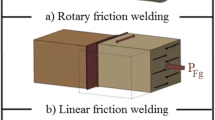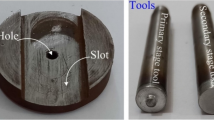Abstract
Joining sheet metal can be problematic using traditional friction welding techniques. Friction crush welding (FCW) offers a high speed process which requires a simple edge preparation and can be applied to out-of-plane geometries. In this work, an implementation of FCW was employed using an additional wire to weld sheets of EN AW5754 H22, DC01, and Cu-DHP. The joint is formed by bringing together two sheet metal parts, introducing a wire into the weld zone and employing a rotating disk which is subject to an external force. The requirements of the welding preparation and the fundamental process variables are shown. Thermal measurements were taken which give evidence about the maximum temperature in the welding center and the temperature in the periphery of the sheet metals being joined. The high welding speed along with a relatively low heat input results in a minimal distortion of the sheet metal and marginal metallurgical changes in the parent material. In the steel specimens, this FCW implementation produces a fine grain microstructure, enhancing mechanical properties in the region of the weld. Aluminum and copper produced mean bond strengths of 77 and 69 pct to that of the parent material, respectively, whilst the steel demonstrated a strength of 98 pct. Using a wire offers the opportunity to use a higher-alloyed additional material and to precisely adjust the additional material volume appropriate for a given material alignment and thickness.






















Similar content being viewed by others
References
International Organization for Standardization: Friction Welding of Metallic Materials, 2000, DIN EN ISO 15620.
Maalekian M, Kozeschnik E, Brantner HP: Acta Materialia, 2008, vol. 56(12), pp. 2843–2855.
W.M. Thomas, E.D. Nicholas, and J.C. Needham: Patent No. 5460317, 1995, US Patent.
Mishra RS, Ma ZY: Materials Science and Engineering Reports, 2005, vol. 50(1-2), pp. 1–78.
S.W. Kallee, D.E. Nicholas, W.M. Thomas: 8th International Conference on Joints in Aluminum, 2002.
Mishra R, Ma Z, Charit I: Materials Science and Engineering, 2003, vol. 341(1-2), pp. 307–310.
Liu FC, Ma ZY: Metallurgical and Materials Transactions A, 2008, vol. 39(10), pp. 2378–2388.
Hwang Y, Kang Z, Chiou Y: International Journal of Machine Tools and Manufacture, 2008, vol. 48(7-8), pp. 778–787.
Nandan R, DebRoy T, Bhadeshia HK: Progress in Materials Science, 2008, vol. 53, pp. 980-1023.
Li X, Li J, Liao Z: Materials & Design, 2016, vol.99, pp. 26-36.
Cavaliere P, Squillace A, Panella F: Journal of Materials Processing Technology, 2008, vol. 200(1–3), pp. 364–372.
P. Schindele: Patent Pending No. WO002013087137A1, 2012, WIPO/PCT.
Besler FA, Schindele P, Grant RJ, Stegmüller MJR: Journal of Materials Processing Technology, 2016, vol. 234, pp. 72–83.
International Organization for Standardization: Welding Consumables-Classification, 2016, DIN EN ISO 18273.
International Organization for Standardization: Destructive Tests on Welds in Metallic Materials, 2013, DIN EN ISO 4136.
International Organization for Standardization: Hardness Testing, 2016, DIN EN ISO 9015-2.
International Organization for Standardization: Metallic Materials-Vickers Hardness Test, 2006, DIN EN ISO 6507-4.
International Organization for Standardization: Visual Testing of Fusion-Welded Joints, 2011, DIN EN ISO 17637.
Toumpis A, Galloway A, Cater S: Materials & Design, 2014, vol. 62, pp.64–75.
International Organization for Standardization: Macroscopic and Microscopic Examination of Welds, 2013, DIN EN ISO 17639.
International Organization for Standardization: Steels-Micrographic Determination of the Apparent Grain Size, 2012, BS EN ISO 643.
Acknowledgments
The authors would like to thank Werner Saft, Maximilian Rehm and German Zeller (Laboratory for Joining and Welding), Professor Dierk Hartmann and Petra Schittenhelm (Laboratory for Material Sciences) and Jochen Ringholz (Laboratory of Energy Technology) at Kempten University of Applied Sciences, Germany, for their support.
Funding
This research did not receive any specific grant from funding agencies in the public, commercial, or not-for-profit sectors.
Author information
Authors and Affiliations
Corresponding author
Additional information
Manuscript submitted March 29, 2017.
Rights and permissions
About this article
Cite this article
Besler, F.A., Grant, R.J., Schindele, P. et al. Advanced Process Possibilities in Friction Crush Welding of Aluminum, Steel, and Copper by Using an Additional Wire. Metall Mater Trans B 48, 2930–2948 (2017). https://doi.org/10.1007/s11663-017-1108-4
Received:
Published:
Issue Date:
DOI: https://doi.org/10.1007/s11663-017-1108-4




